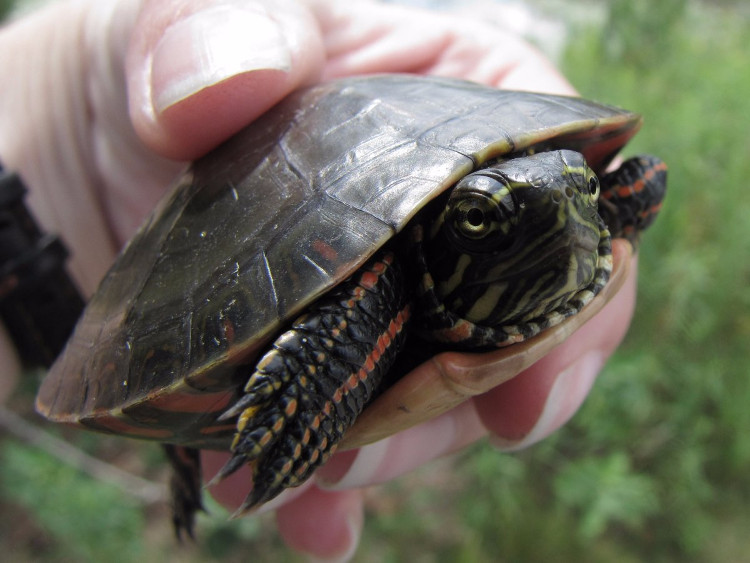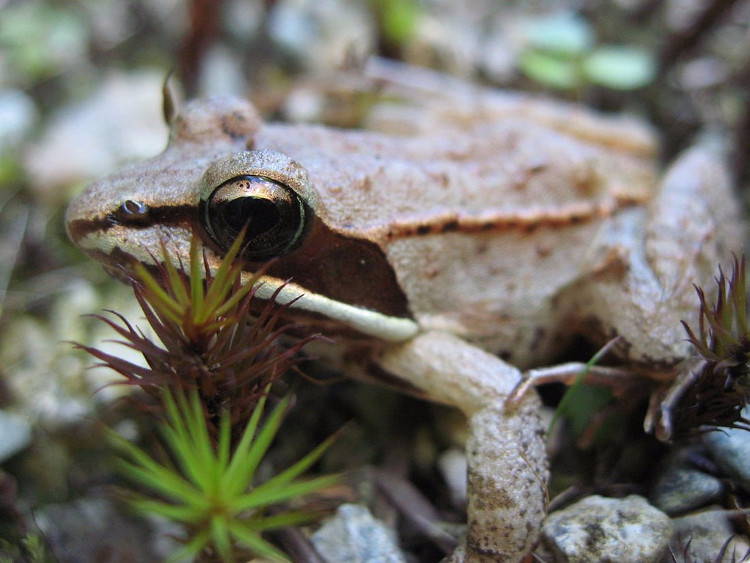7 animals are cold resistant under 0 ° C best on the planet
Some animals are endowed with excellent cold resistance. The bodies of these organisms can produce natural anti-dynamic substances, which help them fight fatal body freezing at temperatures below 0 ° C.
7. Turtle drawing children

Painting turtles are a tough animal, withstand hardships.
Painted turtles are a tough animal that can withstand hardships and that allows them to grow in most areas east of the North American Rocky Mountains. In the colder regions of this mountain range, cold-blooded turtles have developed extreme adaptive abilities to prevent them from freezing to death.
After hatching at the end of the summer or early autumn, most baby turtles find their way to an unfrozen lake or stream to experience their first winter. However, baby-painted turtles that grow in cold climates remain in their nests during the winter, when temperatures can drop below freezing. Young turtles can still survive thanks to the blood that can slow them down, preventing ice crystals from forming even below the freezing temperature of their blood. The thick skin and the tiny amount of water stored in the 5g baby turtles also allow them to cope with the cold.
6. Forest frog

Frogs can survive for up to 2 weeks with more than 60% of their bodies frozen.
Due to the wet habitat and thin skin, pitting holes, amphibians are relatively sensitive to the cold. However, forest frogs are an exception, with the ability to grow from northern Alaska to the Yukon River in North America. The frog's body fights against the attack of cold by producing anti-freezing substances that flood the body, keeping them from freezing. These organisms accumulate urea in their tissues and the liver is responsible for converting glycogen into glucose.
Forest frogs buried themselves under a layer of leaves and often a layer of snow. They can survive for up to 2 weeks with more than 60% of the body freezing. Two-thirds of this bandage forms under the skin and inside the body cavities, because the frogs dry their internal organs in the first 12 hours of freezing.
5. Red bark bug

Red bark is resistant to freezing at temperatures as low as -150 ° C.
The beetles that burrow under the red bark can survive the winter by hiding inside the Alaska poplars, nestled in the wet areas beneath the bark. Just like baby turtles, these bugs resist the cold by slowing freezing, creating anti-freezing proteins to prevent ice crystals from forming in their cells. Scientists found that nothing could slow down as well as this creature. In lab experiments at Alaska Fairbanks University, red bark beets are resistant to freezing at temperatures as low as -150 ° C.
4. Upis bugs

Upis bugs can survive when frozen at temperatures of -76 ° C.
Unlike cousins of red bark beetles, Upis beetles give in to the cold. These beetles select dry tree niches and avoid moist water to cope with hardening. They expel water from their cells, preventing dangerous cell cracking caused by large bulging stone crystals. This dehydration strategy means they still do not freeze at -7.5 ° C and can survive while freezing at -76 ° C.
3. Arctic ground squirrel

This is the only mammal that can withstand closure below 0 ° C.
Arctic ground squirrels are the only mammals on the list of species that can resist freezing below 0 ° C. Although many mammals are able to cope with the cold with dense hair or hibernate during cold months, none of these are comparable to the ability of Arctic squirrels.They can super cool their bodies below freezing, to -2.9 ° C, a record in the mammalian world.
However, really impressive adaptations occur in the brains of Arctic ground squirrels. They can cut nerve connections, synapses to hibernate, then reconnect them immediately after awakening and warm the body, almost every 2-3 weeks during the winter.
Hibernation causes nerve cells to receive chemical messages from cramped neurons. A Russian study in the early 1990s found that the brain is severed from the nerve connections of Arctic ground squirrels in the midst of hibernation that contains fewer nerve cells than their brains. when awakened and recovered at a warmer climate.
And only 2 hours after awakening from sleep, their nerve connections are restored and there are even more neuronal branches than before. However, 12 - 15 hours later, the brain began to disconnect the connections again when the squirrel returned to hibernation.
2. Moths of the Arctic moth

This species survived the cold by playing waiting games.
Arctic moths survive the cold by playing waiting games. Most brood moths hatch in the spring and spend several months consuming essential nutrients before getting into cocoons and turning into moths or butterflies.
However, the Northern caterpillar moth does not go through that cycle. In colder regions, where summer passes, moths take many seasons to grow into nymphs, eat as much as possible in June and before entering hibernation that lasts for most of the year. Their hearts stop beating, breathing stops and the caterpillar body produces natural glycerol-like antifreeze to protect their cells from ice crystals. They even degrade cellular mitochondria during hibernation.
Caterpillars undergo nearly 90% of their lives in frozen and awake state to eat the Arctic willow tree. And if they collect enough nutrients, they will continue their pupal state and then become mature moths. And if more food is needed when the weather is gone, the caterpillar will return to hibernation. Thanks to this patience, moths of the Arctic caterpillars are the longest-lived moths, their lifespans last for years while most other butterflies are only completed within a few months.
1. Water Bear (Tardigrade)

Water bears are the best cold-resistant species on the planet.
No creature can compare impressive anti-chilling ability like tardigrade. Microorganisms commonly known as water bears can survive almost in all conditions, at extremely high or extremely low temperatures, exposure to large amounts of radiation, dehydration and even vacuum environments.
Water bears can almost survive at temperatures when matter atoms stop moving. An individual of this species, nicknamed Mike persistent, was resistant to a temperature of -273 ° C in the laboratory.
Water bears were also recorded to survive at temperatures as high as 150 ° C, above the boiling point of water. Not only that, they survived no harm through their dry state. A recent study has successfully revitalized frozen water bears in 1983 and they are still able to grow well and reproduce later.
- Why are some animals still alive even if the blood freezes?
- Decipher the greatness of cold native animals
- What is cold-blooded animals? Basic information you need to know
- Detection of super-cold ice planets with mass like Earth
- What would happen if humans were ... 'cold-blooded animals'?
- 10 degrees Celsius, flowers still grow
- Cold-blooded animals are able to adapt quickly to climate change
- Cold-blooded creature
- All kinds of animals survive when the price is cold
- Inoculate the stool to kill resistant bacteria in the intestine
- Cold in the Middle Ages is returning to Earth
- Swimsuits, dive-resistant, cold-drawn animals
 Animal 'suffering' after hibernation
Animal 'suffering' after hibernation Why do goats climb well?
Why do goats climb well? Scientists were surprised to see chimpanzees eating turtles
Scientists were surprised to see chimpanzees eating turtles Giant catfish died deadly due to drought in Thailand
Giant catfish died deadly due to drought in Thailand